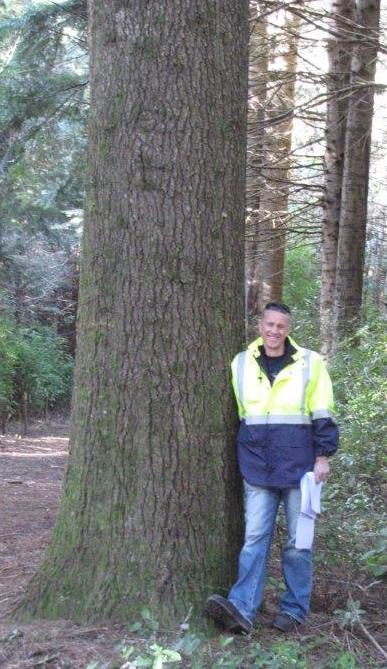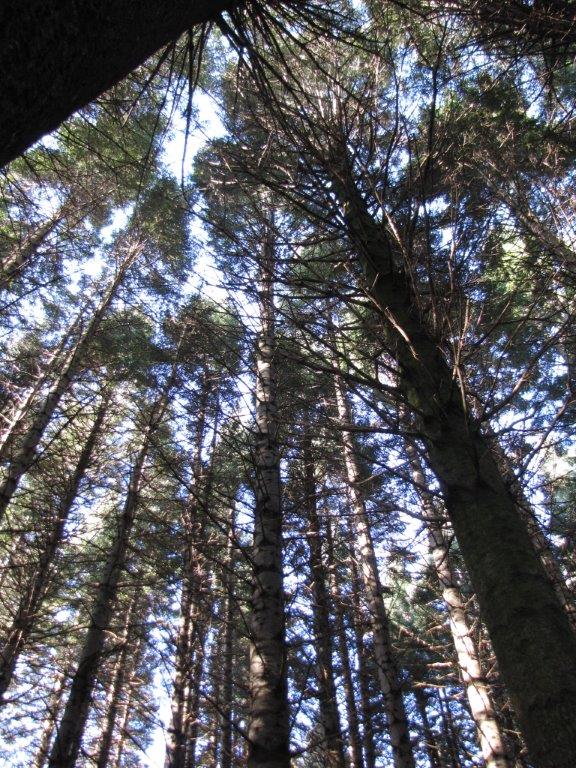Report: Trees for steep slopes

Dean Satchell
Sustainable Forest Solutions
dsatch@gmail.com
Reviewed by Mike Marden, July 2018.
PDF download of this report ».
Please note that the web report is regularly updated whereas the pdf download above is dated July 2018.
Fir, silver
| Species rating * | |
|---|---|
| Early growth rate | 4 |
| Permanent canopy | 10 |
| Root decay rate | 4 |
| Productivity | 8 |
| Timber value | 5 |
| Coppicing | 0 |
| Total rating | 5.7 |
In a nutshell
Silver fir is very productive over long rotations, lending itself well to steepland regimes for controlling erosion. Silver fir could be confidently deployed in lower North Island steepland country but would require careful management in the establishment stage.
The silver firs are a large group of species in the Abies genus. In their natural environment they become very large trees that "occupy relatively cool, moist sites at middle to high elevations in mountainous areas" (Miller & Knowles, 1989). Firs are climax species and in their natural environment regenerate within the existing forest structure, so have slower early growth characteristics compared with pioneer or fire-succession species (Miller & Knowles, 1989).

Species in the Abies genus are very healthy in New Zealand with many fine specimens existing (Miller & Knowles, 1989). However, Abies has been neglected by foresters and researchers in New Zealand, despite some species having good growth rates (Miller & Knowles, 1989; Low, 2011). Silver fir produces a general purpose softwood timber similar to radiata pine, which, along with other qualities such as good health and tolerance of a wide range of sites, justify its place as a "contingency species" in terms of biological risk to radiata pine (Miller & Knowles, 1989). Because of slower initial growth rates than radiata pine, silver fir would not be expected to be competitive with radiata on many sites and on shorter rotations, but on highly erodible hill country longer rotations that produce similar annualised volumes of wood may have considerable appeal to growers and investors because of the reduced risk for serious erosion.
Siting and growth

Although comprehensive provenance trials were planted between 1957 and 1968 across 19 sites, these were subject to neglect and as a result the information these have provided to date is limited (Low, 2011). The main trials in the series were sited at Hawkes Bay and North Canterbury (Miller & Knowles, 1989). Despite general neglect such as trees being swamped by rank grass and gorse (Miller & Knowles) these trials demonstrated the considerable potential Abies spp. hold for plantation forestry in New Zealand, with impressive mean annual increments of 30 cubic metres per year and very good health (Low, 2011). A.grandis (grand fir) and A. concolor (white fir) have generally survived and grown well in the trials and although only planted at two sites, the best Abies religiosa (sacred fir) outgrew all other species.
Poor establishment in the historical trials is also attributed to lack of mycorrhiza (Low, 2011), an issue easily addressed using modern nursery practices. Indeed, properly inoculated seedlings now establish well in the field (R. Appleton, pers. comm). The slow initial growth in the original trials could also be attributed to grass and weed competition, now easily addressed using modern practices such as application of nitrogen fertiliser and herbicide releasing of young trees, necessary until the trees have formed strong leaders (Miller & Knowles, 1989). This is standard practice now for species such as redwood that also experienced poor and slow establishment historically, but now have good survival and early growth (Libby, 2007).
Growth rate for A. grandis in New Zealand is comparable with Douglas fir (Miller & Knowles, 1989). Health is excellent compared with Douglas fir, with Abies species carrying up to 10 years of living foliage (C. Low, pers. comm), compared with only 1 - 3 years foliage carried on Douglas fir as a result of Swiss needlecast disease (Miller & Knowles, 1989).

Unimproved seedlines imported from North America for both A. grandis and A. concolor "had good form, with straight stems, regular branching and few forks". Miller & Knowles (1989) suggested that a breeding programme should be established as grafted seed orchards so the best provenances could be developed as a viable contingency. However, this has not been undertaken to date.
The most promising Abies species for lowland New Zealand conditions appears to be Abies grandis. Provenance does not appear to be an issue with siting the species and with no obvious latitudinal trend (Low, 2011). In lowland sites A. grandis grows better than A. concolor, which may be better suited to higher elevations. A. concolor may be able to sustain higher stockings than other species (Low, 2011) because of its dense crown and narrow pyramidal form. These two species hybridise naturally where their elevation preferences meet and one A. concolor seedlot that may have been collected from such a hybrid swarm in its natural range performed better across all sites than the other A. concolor seedlots (Low, 2011). Abies grandis tolerates moderate exposure and prefers well distributed rainfalls above 1000 mm, but will grow in drier climates (750 mm annual rainfall) (Miller & Knowles, 1989). Abies grandis is less tolerant of exposure than A. concolor, whereas A. pinsapo (Spanish fir) tolerates drier sites and periodic strong winds (Miller & Knowles, 1989). Although A. religiosa has the fastest growth rates, being frost tender it is only suited to low-elevation sites (Miller & Knowles, 1989), with good examples at the Longmile Rotorua (C. Low, pers. comm). Abies magnifica (Red fir), on the other hand, being a high elevation species is not tolerant of lowland sites where it appears to suffer from root rot (C. Low, pers. comm).
Fir species are wind-tolerant and relatively tolerant of bony soils as found in exposed erodible steeplands (C. Low, pers. comm). However, A. concolor may tolerate greater wind exposure than A. grandis, with its narrower crown and finer-branched architecture. The Hanmer trial site is particularly boney and exposed to Canterbury nor-wester winds and A. concolor has performed particularly well there, with no windthrow (C. Low, pers. comm). True fir species appear to be more wind tolerant than Douglas fir and with superior volume production over time (C. Low, pers. comm). True fir species are also very tolerant of snow (R. Appleton, pers. comm). Although diameter growth is 10-15% less than good provenances of Douglas fir for the first 10-15 years (R. Appleton, pers. comm), because of crown density and foliar health, basal area and volume exceed what Douglas fir is capable of over productive rotations.
Abies species are relatively sensitive to low nutrition (R. Appleton, pers. comm). Growth rates may be considerably reduced on slip faces that are devoid of topsoil, if these are both nutrient and moisture deficient (R. Appleton, pers. comm). Fir species also require free-draining soils and are not tolerant of excessive soil moisture levels (R. Appleton, pers. comm).
Management and silviculture
The suggested silvicultural regime for New Zealand is for an initial stocking of 1667 stems/ha (3m x 2m), thinned at about 17 years of age when the top height is 14 m to 500 stems/ha, for a rotation length of 40 years or more (Miller & Knowles, 1989).
Stocking can be high for Abies grandis and A. concolor because of exceptional foliage health and shade tolerance, resulting in a high basal area (Low, 2011). These species have narrow conical form with small abundant branches that are shade-tolerant, lending them to regimes with longer rotations and higher stocking rates (Low, 2011). At age 47 in Gwavas forest Hawkes Bay, A. grandis had standing volumes of 1500 cubic metres at an average stocking of 400 stems per hectare, a third higher than for Douglas fir of the same age (Low, 2011). The largest trees had diameters of over 80cm and Low (2011) suggested that stocking should be higher for better volume production, because superior volume growth at this age was exhibited by stands at 600 stems per hectare.
In its natural habitat grand fir does not establish beneath a closed canopy, but establishes in light to moderate understory shade and in small openings in mature forests (Hood et al. 2018), suggesting that grand fir is very suitable for continouos cover forestry.
On dry sites a well-developed taproot grows to moderate depths, while on moist sites shallow lateral roots prevail and the taproot may be absent. Depth of horizontal roots is moderate compared to associated conifers (Hood et al. 2018).
Weed potential
Although on suitable sites regeneration has sporadically taken place under parent stands, no Abies species has shown any tendency to spread more widely (Miller & Knowles, 1989).
Timber
In North America, silver fir species are prominent producers of both sawn timber and pulp (Miller & Knowles, 1989).
Although the timber has traditionally not been as highly regarded as Douglas fir (Low, 2011), strength properties are only slightly below those of Douglas fir and stiffness values are second only to Douglas fir in terms of Western North American softwood species (WWPA). However, data has not been published on timber properties for New Zealand material. In North America fir timber is marketed under the generic species combination "hem-fir" (an umbrella term for species with similar wood) comprising Western hemlock and five of the true fir species (WWPA).
Fir timbers "are soft, whitish in colour and easily worked to a good finish, taking paint and varnish well" (Miller & Knowles, 1989). Fir species have become preferred construction timbers because of the ability to hold nails and screws well with a resistance to splitting, a low propensity for splintering when sawed and a straight-grained, non-resinous, fine-textured, stiff and strong timber. (WWPA).
Fir timber is not resistant to decay, but "as roundwood they will absorb fluid preservatives applied under pressure, or using a hot and cold impregnation method" and "treated in the round they make serviceable posts and poles" (Miller & Knowles, 1989). Sawn silver fir is easily treated with preservatives (AWPA) and treated fir timber is commonly used for structural decking on account of its strength and beauty (WWPA).
Although not as strong as the Douglas fir-larch species combination sold in North America, silver fir has a very high modulus of elasticity (MOE) for its weight and has excellent stiffness-to-weight ratios (WWPA). Because of its low natural durability, for structural applications the H1.2 hazard class (NZS 3640:2003) specifies treatment with boron to 0.4% BAE retention for softwoods. Boron preservative treatment provides "deep penetration and hence full protection" for fir species (Lloyd, 1995).
Natural stands of fir are also an importance source of pulpwood (Miller & Knowles, 1989).
Disclaimer: The opinions and information provided in this report have been provided in good faith and on the basis that every endeavour has been made to be accurate and not misleading and to exercise reasonable care, skill and judgement in providing such opinions and information. The Author and NZFFA will not be responsible if information is inaccurate or not up to date, nor will we be responsible if you use or rely on the information in any way.
